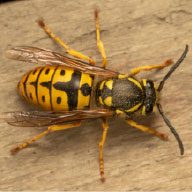Yellow Jackets
Black or dark brown with yellow markings on the body; thin, defined waist; 3/8 to 5/8 inch in length

Diet: Yellow jackets like sweets and meats, so foods rich in sugars and carbohydrates such as plant nectar and fruit, and insects like flies and caterpillars.
Habitat: Most active in late summer into fall, yellow jackets are considered one of the most aggressive wasps. Yellow jackets can have ground nests and aerial nests. Burrow nests are usually left behind by rodents while above-ground nests are found in trees, shrubs, and on the side of buildings. Either nest can have a colony ranging from 500 to thousands of members.
Threats: Yellow jackets can sting if they are disturbed or feel threatened while foraging or if their nest is disturbed and have the ability to sting repeatedly.
Control: Keep garbage away from the home with fitted lids and ensure windows and doors have screens so pests cannot enter the home. Yellow jackets enjoy meats and sweets, so if you are outdoors, keep food covered and avoid perfumes with sweet or floral notes. If you think you have a yellow jacket nest on your property, do not interact with or attempt to remove it. Contact a professional pest control company.
